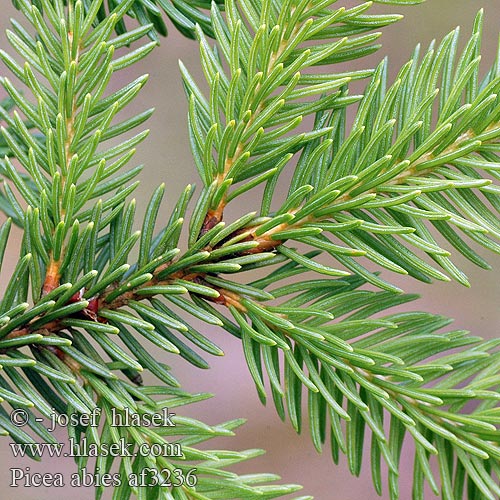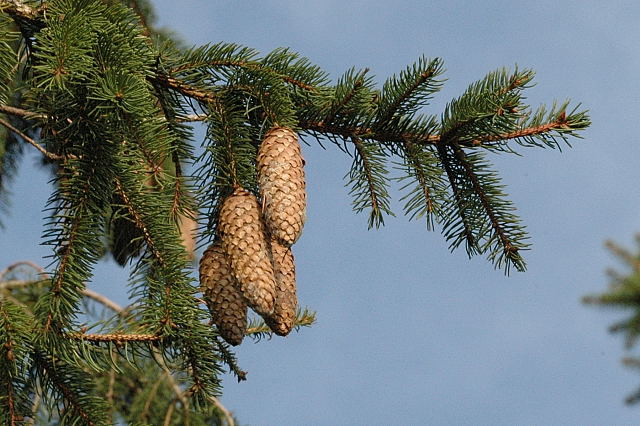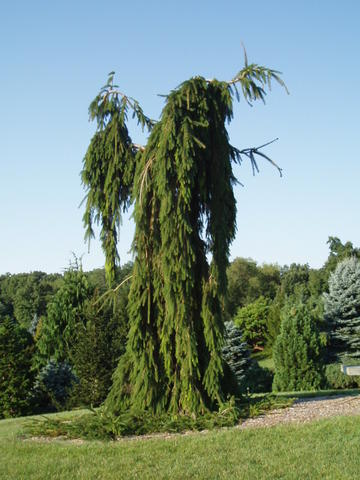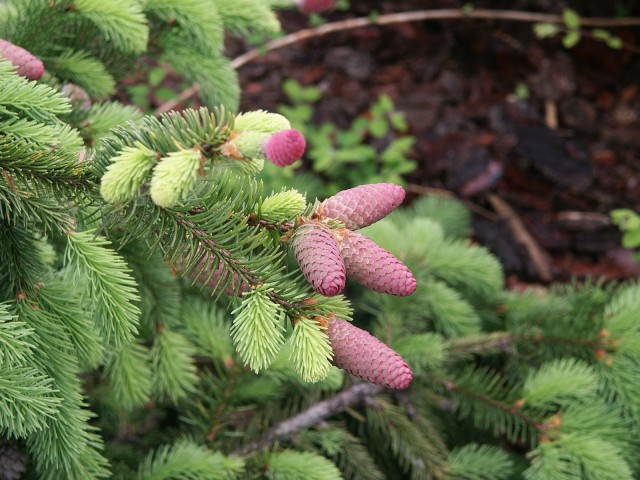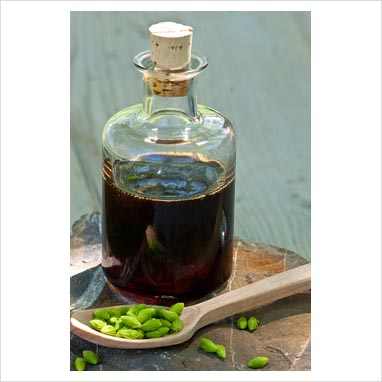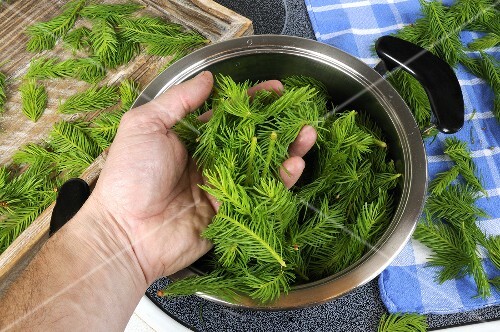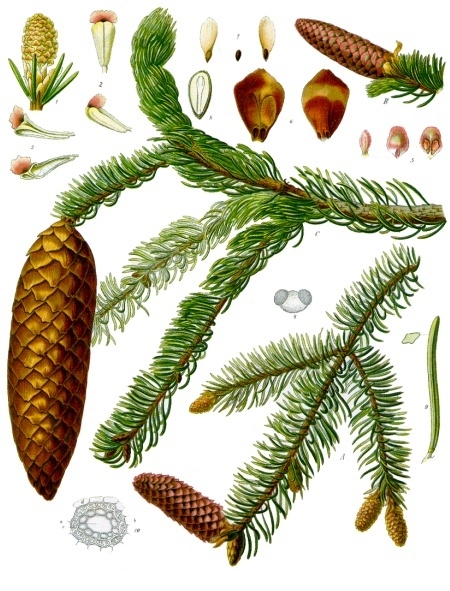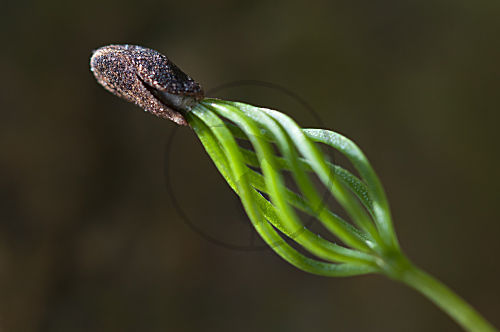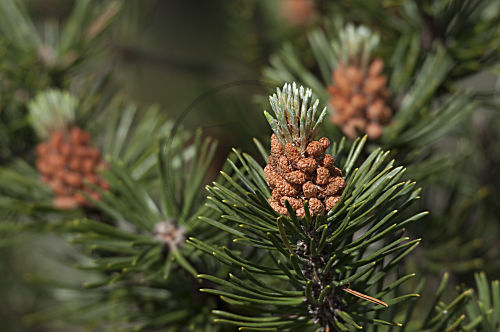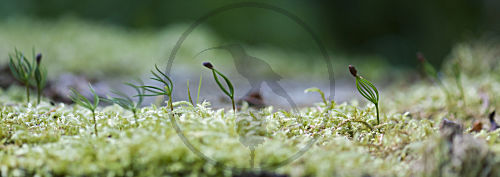You are using an out of date browser. It may not display this or other websites correctly.
You should upgrade or use an alternative browser.
You should upgrade or use an alternative browser.
گروه تهیه عکس و فیلم تالار گیاهان دارویی-هفته اول : گیاه کاج نوئل (Picea abies)
- شروع کننده موضوع * ziba *
- تاریخ شروع

Gymnosperm root cap turnover induced by removal of border cells. A root tip of a Picea abies seedling is shown surrounded by border cells that dispersed during immersion for 1 min in water. Border cell viability in spruce, measured by microscopic observation of cytoplasmic streaming, was 87 ± 8%. Photo courtesy Dr. Berit Swensen


Remedies from spruce resin (Picea abies) are well known in traditional folk medicine all around the globe. Ointment from spruce resin is used for treating wounds, healing pressure ulcers, infections, burns, insect bites and to cure various other skin problems. It is also very recommended for massage of painful joints and muscles.
OBLAK'S SPRUCE RESIN OINTMENT
75 mL (2.5 oz)
SPRUCE RESIN OINTMENT (SALVE) is 100% natural and organic. Main active ingredients are spruce resin, marigold (calendula) and common yarrow extracts, vitamin E and alpha-bisabolol (anti inflammatory). Ointment base is made of 100% natural vegetable Vaseline (olus oil), which is a mixture of triglycerides from vegetable origin produced according to a unique patented formulation and is a vegetable substitute to petrolatum. Ointment base includes also organic oils from jojoba, olive, sunflower and almond, beeswax, lanolin and shea butter.
SPRUCE RESIN is organic substance which protects and heals the wounds of the tree from damages and infections caused from external influence. Remedies (ointments) from spruce resin are used in traditional folk medicine to heal injuries and diseases for centuries. Blood circulation and lymph stimulation is increased on the spot where we apply spruce resin. This helps with faster regeneration and healing. Spruce resin also has proved antimicrobial properties.PURPOSE AND USAGE: Ointment is used for massages for better blood circulation and faster regeneration of stiff back, shoulders, painful joints and tired limbs. It also relive pain caused by rheumatism, gout, sciatica, arthritis and reduce swellings. Apply the ointment over desired area few times a day and gently rub it into skin in a circular motions. The spruce resin ointment is also used to heal skin injuries or unpleasant skin conditions such as wounds, burns, infections, ulcers, insect bites, herpes, blisters, abrasions, fungus ailments and similar. Use the ointment few times daily. Do not use it directly on fresh open wounds. You can use various protective fabric or bandage on the area with applied ointment but be careful not to wrap it to hard. Blood needs to circulate freely. Ointment can be also used for general reviving and regenerative skin care.Caution: For external use only. In case of allergic reaction, stop using it. Pecking feeling might appear sometimes at the beginning of usage due to increased blood circulation. Store it at temperatures below 25°C. Keep away from children.
Find more info at: http://spruceresin.com/http://www.spruceresin.com

Pinaceae - Abies pectinata - Pinus picea.
From: Medical botany by William Woodville.
London, James Phillips, 1793, 1. edition, volume 3, plate 209. Hand-coloured engraving (sheet 173 x 227 mm). Text enclosed.
€ 80
William Woodville is noted for his early advocacy of the theory of vaccination and for these excellent volumes on Medical Botany (Hunt). This work contains systematic and general descriptions of all the plants in the catalogues of the materia medica published by the Royal Colleges of Physicians of London and Edinburgh, and is illustrated with excellent plates drawn and engraved by James Sowerby (Henrey).
* Pritzel 10.398; Dunthorne 334; Great flower books p. 81; Hunt 716; Nissen BBI 2183; Henrey 1521 + I p. 30.

TLC of acetone extracts from knots in Parana pine (Araucaria angustifolia), silver fir (Abies alba), and Norway spruce (Picea abies) trees. Silica Gel 60 PF-254 plates (Merck). Eluent: dichloromethane:ethanol 93:7 (v/v). Detection: spray with sulphuric acid in ethanol, followed by 2 min heating at 150 °C, giving the following colours for the lignans: Pino, Me-Pino, Me2-Pino, and lignan A: violet; MR, Coni, and HMR (HMR and allo-HMR): red or red-brown; Lari and cLari: dark grey; Seco, Me-Seco, and Todo: blue. All lignans were also extracted from the plates and identified by GC–MS and comparison to authentic samples.
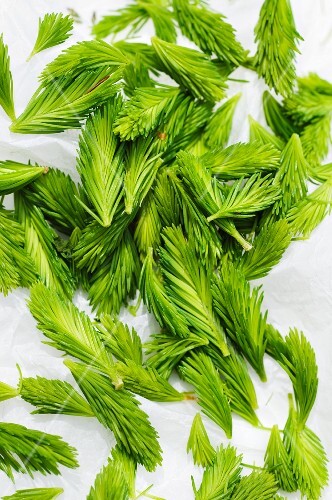
Light green spruce shoots

A spruce with light green shoots

Spruce tip liqueur (Picea abies)
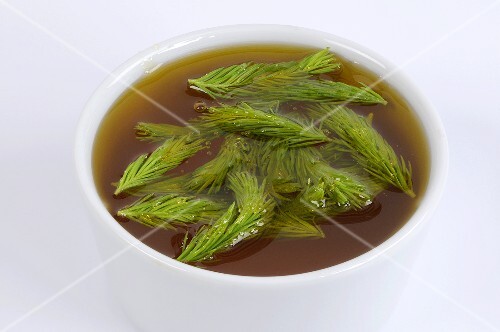
Spruce tip honey (Household remedy for coughs and colds)

Spruce tip honey (Household remedy for coughs and colds)

Spruce tip syrup and honey

Spruce tip honey (Household remedy for coughs and colds)
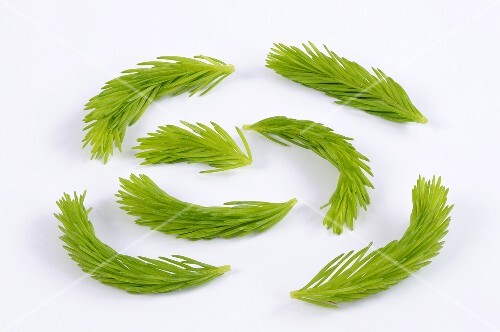
Norway spruce (Picea abies)
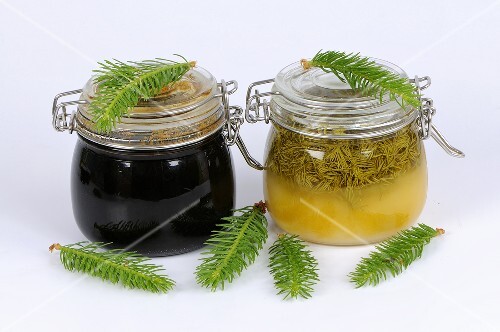
Spruce tip syrup and honey

Chopping spruce tips

Norway spruce (Picea abies)

Raman spectra of the needles of conifers: (1): Tsuga canadensis, (2): Abies concolor, (3): Cedrus atlantica ‘Glauca’, (4): Picea abies, (5): Picea glauca ‘Conica’, (6): Picea omorica, (7): Picea pungens ‘Glauca’, (8): Pinus cembra, (9): Pinus mugo mughus, (10): Pinus mugo ‘Mops’, (11): Pinus nigra nigra, (12): Pinus strobus.

Phloxine B staining of a Picea abies needle. This needle was previously embedded in Parablast and used for flow measurements with the new method before it was connected to a reservoir with staining solution. The cross-section shows staining only in the xylem but not in the transfusion tissue or mesophyll, or in resin ducts (lower border of image).
Xylem anatomical parameters of needles and axes of Picea abies
| 0 | 1 | 2 | n (0/1/2) | |
| Needles | ||||
| Needle area (mm[SUP]2[/SUP]) | 0.76±0.01 a | 0.63±0.02 b | 0.61±0.02 b | 5/5/2 |
| Xylem area (μm[SUP]2[/SUP]) | 2288±102 a,b | 2200±80 a | 2521±99 b | 13/13/17 |
| Tracheid diameter d (μm) | 3.81±0.13 a | 3.64±0.10 a | 3.70±0.10 a | 12/11/12 |
| Hydraulic diameter d[SUB]h[/SUB] (μm) | 5.22±0.14 a | 5.19±0.14 a | 5.27±0.16 a | 12/11/12 |
| Axes | ||||
| Tracheid diameter d (μm) | 6.40±0.35 a* | 7.25±0.38 a* | 7.03±0.39 a* | 4/5/4 |
| Hydraulic diameter d[SUB]h[/SUB] (μm) | 8.61±0.34 a* | 9.87±0.35 a* | 10.12±0.47 a* | 4/5/4 |
- Mean cross-sectional areas of needles and needle xylem, mean tracheid diameter (d), and mean hydraulic diameter (d[SUB]h[/SUB]) of tracheids in needle and axes xylem are given. Columns show values of current year (0), 1-year-old (1), and 2-year-old (2) samples of needles and axes. Values of each line not followed by the same letter differ significantly. Significant differences inK[SUB]s[/SUB] between needles and axes xylem (within rows) are marked by asterisks. Mean ±SE. P ≤0.05. n=number of samples.

Temperature course of Picea abies needles during preparation and measurement with the new method. Times for arrangement and cooling of needles (A), addition of fluid Parablast (B), curing of the Parablast block (C), transfer to the ice-cooled water bath and sealing into the hydraulic system (D), and measurements (E) are indicated by the horizontal bar.
Hydraulic conductivities of the xylem in needles and axes of Picea abies
| K[SUB]s[/SUB] (m[SUP]2[/SUP]×s[SUP]−1[/SUP]×MPa[SUP]−1[/SUP]×10[SUP]−4[/SUP]) | 0 | 1 | 2 | n (0/1/2) |
| Needles | 4.23±0.64 a | 4.09±0.68 a,b | 2.18±0.43 b | 20/18/10 |
| Axes | 4.82±0.57 a | 5.65±0.36 a | 4.86±0.74 a* | 6/9/8 |
- Specific hydraulic conductivity (K[SUB]s[/SUB], m[SUP]2[/SUP] s[SUP]−1[/SUP] MPa[SUP]−1[/SUP]×10[SUP]−4[/SUP]) of the xylem of current year (0), 1-year-old (1), and 2-year-old (2) samples of needles and axes. Values in each row not followed by the same letter differ significantly. Significant differences inK[SUB]S[/SUB] between needles and axes xylem (within rows) are marked by asterisks. Mean ±SE. P ≤ 0.05. n=number of samples.
Xylem anatomical parameters of needles and axes of Picea abies
| 0 | 1 | 2 | n (0/1/2) | |
| Needles | ||||
| Needle area (mm[SUP]2[/SUP]) | 0.76±0.01 a | 0.63±0.02 b | 0.61±0.02 b | 5/5/2 |
| Xylem area (μm[SUP]2[/SUP]) | 2288±102 a,b | 2200±80 a | 2521±99 b | 13/13/17 |
| Tracheid diameter d (μm) | 3.81±0.13 a | 3.64±0.10 a | 3.70±0.10 a | 12/11/12 |
| Hydraulic diameter d[SUB]h[/SUB] (μm) | 5.22±0.14 a | 5.19±0.14 a | 5.27±0.16 a | 12/11/12 |
| Axes | ||||
| Tracheid diameter d (μm) | 6.40±0.35 a* | 7.25±0.38 a* | 7.03±0.39 a* | 4/5/4 |
| Hydraulic diameter d[SUB]h[/SUB] (μm) | 8.61±0.34 a* | 9.87±0.35 a* | 10.12±0.47 a* | 4/5/4 |
- Mean cross-sectional areas of needles and needle xylem, mean tracheid diameter (d), and mean hydraulic diameter (d[SUB]h[/SUB]) of tracheids in needle and axes xylem are given. Columns show values of current year (0), 1-year-old (1), and 2-year-old (2) samples of needles and axes. Values of each line not followed by the same letter differ significantly. Significant differences inK[SUB]s[/SUB] between needles and axes xylem (within rows) are marked by asterisks. Mean ±SE. P ≤0.05. n=number of samples.

Frequency distribution of conduit diameters in the xylem of needles of Picea abies. The relative number of conduits is given for 1 μm classes and shown for current year, 1-year-old, and 2-year old samples of needles (N0, N1, and N2).

Cross-sectional areas along needles of Picea abies. The mean cross-sectional areas of the whole needle, the area within the endodermis, and of the xylem are shown for 2 mm sections of ∼16 mm long current year (N0), 1-year-old (N1), and 2-year-old needles (N2). Mean SE is indicated on the left top of each panel. n=5.
Cinara piceicola (Green-striped Spruce Aphid)


On Spruce, especially Norway Spruce (Picea abies) in colonies on bark of woody shoots between needle-bases in spring. They move to older branches and roots in summer. Found in north, west and central Europe, and apparently China.
Cinara costata (Mealy Spruce Aphid)

Forms small colonies on smaller woody twigs on lower branches of Spruces (Picea spp.). The twigs also receive a deposit of mealy wax and the aphids are not usually attended by ants. It occurs in Europe, east Asia, Australia, Greenland, Canada and USA.
Cinara pruinosa (Wax-bordered Spruce Aphid)

In small colonies on woody twigs of Spruce (Picea spp.) in spring, but later found at base of trunk and on roots in ant shelters. The species generally overwinters as eggs, but anholocyclic overwintering on roots also occurs. Throughout most of Europe eastward to Turkey, and in North America (where often recorded as palmerae).


On Spruce, especially Norway Spruce (Picea abies) in colonies on bark of woody shoots between needle-bases in spring. They move to older branches and roots in summer. Found in north, west and central Europe, and apparently China.
Cinara costata (Mealy Spruce Aphid)

Forms small colonies on smaller woody twigs on lower branches of Spruces (Picea spp.). The twigs also receive a deposit of mealy wax and the aphids are not usually attended by ants. It occurs in Europe, east Asia, Australia, Greenland, Canada and USA.
Cinara pruinosa (Wax-bordered Spruce Aphid)

In small colonies on woody twigs of Spruce (Picea spp.) in spring, but later found at base of trunk and on roots in ant shelters. The species generally overwinters as eggs, but anholocyclic overwintering on roots also occurs. Throughout most of Europe eastward to Turkey, and in North America (where often recorded as palmerae).
محدوده پراکندگی
محدوده پراکندگی

محدوده پراکندگی
Picea abies female green
Picea abies female green

Picea abies female green

Picea abies female red
Picea abies female red

Picea abies female red

Similar threads
Similar threads
-
تاپیک راهبردی گروه تهیه عکس و فیلم تالار گیاهان دارویی-هفته دوم : گیاه سرخار گل (Echinacea purpurea)
- شروع شده توسط "Pejman"
- پاسخ ها: 28
-
گروه تهیه مقاله و مستندات علمی تالار گیاهان دارویی-هفته اول : گیاه کاج نوئل (Picea abies)
- شروع شده توسط orkidehm
- پاسخ ها: 21
-
تاپیک راهبردی گروه تهیه مقاله و مستندات علمی تالار گیاهان دارویی-هفته دوم: گیاه سرخار گل (Echinacea purpurea)
- شروع شده توسط "Pejman"
- پاسخ ها: 9
-
گروه ترجمه تالار گیاهان دارویی-هفته اول : گیاه کاج نوئل (Picea abies)
- شروع شده توسط "Pejman"
- پاسخ ها: 10
-
گروه پژوهش تالار گیاهان دارویی-هفته اول : گیاه کاج نوئل (Picea abies)
- شروع شده توسط mastane20
- پاسخ ها: 20


